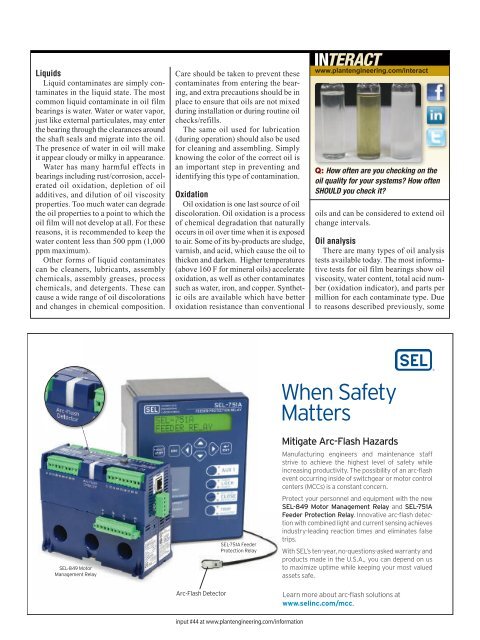2012 - PageSuite
2012 - PageSuite
2012 - PageSuite
Create successful ePaper yourself
Turn your PDF publications into a flip-book with our unique Google optimized e-Paper software.
Liquids<br />
Liquid contaminates are simply contaminates<br />
in the liquid state. The most<br />
common liquid contaminate in oil film<br />
bearings is water. Water or water vapor,<br />
just like external particulates, may enter<br />
the bearing through the clearances around<br />
the shaft seals and migrate into the oil.<br />
The presence of water in oil will make<br />
it appear cloudy or milky in appearance.<br />
Water has many harmful effects in<br />
bearings including rust/corrosion, accelerated<br />
oil oxidation, depletion of oil<br />
additives, and dilution of oil viscosity<br />
properties. Too much water can degrade<br />
the oil properties to a point to which the<br />
oil film will not develop at all. For these<br />
reasons, it is recommended to keep the<br />
water content less than 500 ppm (1,000<br />
ppm maximum).<br />
Other forms of liquid contaminates<br />
can be cleaners, lubricants, assembly<br />
chemicals, assembly greases, process<br />
chemicals, and detergents. These can<br />
cause a wide range of oil discolorations<br />
and changes in chemical composition.<br />
Care should be taken to prevent these<br />
contaminates from entering the bearing,<br />
and extra precautions should be in<br />
place to ensure that oils are not mixed<br />
during installation or during routine oil<br />
checks/refills.<br />
The same oil used for lubrication<br />
(during operation) should also be used<br />
for cleaning and assembling. Simply<br />
knowing the color of the correct oil is<br />
an important step in preventing and<br />
identifying this type of contamination.<br />
Oxidation<br />
Oil oxidation is one last source of oil<br />
discoloration. Oil oxidation is a process<br />
of chemical degradation that naturally<br />
occurs in oil over time when it is exposed<br />
to air. Some of its by-products are sludge,<br />
varnish, and acid, which cause the oil to<br />
thicken and darken. Higher temperatures<br />
(above 160 F for mineral oils) accelerate<br />
oxidation, as well as other contaminates<br />
such as water, iron, and copper. Synthetic<br />
oils are available which have better<br />
oxidation resistance than conventional<br />
INTERACT<br />
www.plantengineering.com/interact<br />
Q: How often are you checking on the<br />
oil quality for your systems How often<br />
SHOULD you check it<br />
oils and can be considered to extend oil<br />
change intervals.<br />
Oil analysis<br />
There are many types of oil analysis<br />
tests available today. The most informative<br />
tests for oil film bearings show oil<br />
viscosity, water content, total acid number<br />
(oxidation indicator), and parts per<br />
million for each contaminate type. Due<br />
to reasons described previously, some<br />
input #44 at www.plantengineering.com/information

















